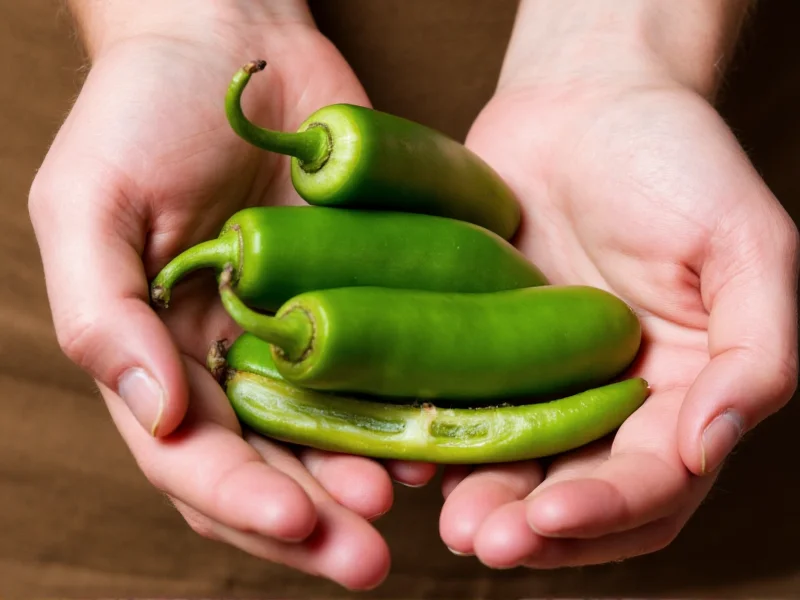If you've ever handled jalapeños while cooking and later felt an intense burning sensation on your hands, you've experienced what's commonly called jalapeno hands. This condition affects home cooks, chefs, and gardeners who handle hot peppers without proper protection. Understanding why this happens and how to address it can save you significant discomfort during meal preparation.
The Science Behind Jalapeno Hands
Jalapeno hands result from exposure to capsaicin, the active compound responsible for the heat in chili peppers. Capsaicin binds to TRPV1 receptors in your skin—receptors designed to detect actual heat and signal pain to your brain. When these receptors activate, your nervous system interprets the sensation as actual burning, even though no thermal damage has occurred.
Unlike many irritants, capsaicin is oil-soluble rather than water-soluble. This explains why washing with water alone often makes the burning sensation worse—it spreads the oil across your skin without effectively removing it. The intensity of the reaction varies based on pepper variety (jalapeños range from 2,500–8,000 Scoville units), skin sensitivity, and duration of exposure.
Symptoms of Capsaicin Exposure
Symptoms typically appear within minutes of handling peppers and may include:
- Burning or stinging sensation on contact areas
- Redness and inflammation
- Temporary numbness following initial burning
- Increased sensitivity to temperature changes
- Potential transfer to other body parts (eyes, face)
Immediate Treatment Options for Jalapeno Hands
When you first notice the burning sensation, prompt action can significantly reduce discomfort. The following methods effectively neutralize capsaicin:
| Treatment Method | How It Works | Effectiveness Timeline |
|---|---|---|
| Oil-based cleanser (cooking oil, dish soap) | Dissolves capsaicin oil through "like dissolves like" principle | Noticeable relief within 2-5 minutes |
| Milk or dairy products | Casein protein binds to and removes capsaicin | Reduces burning in 3-7 minutes |
| Vinegar solution (1:1 with water) | Acid neutralizes alkaline capsaicin compounds | Moderate relief after 5-10 minutes |
| Commercial capsaicin removers | Specially formulated to break down capsaicin molecules | Rapid relief (1-3 minutes) |
Step-by-Step Treatment Protocol
For optimal results when treating jalapeno hands:
- Immediately stop handling peppers and remove any visible debris
- Wash hands with oil-based dish soap (not just water)
- Apply full-fat dairy product (milk, yogurt) and gently rub affected areas
- Rinse with cool (not cold) water
- Repeat if burning persists
- Apply moisturizer to prevent skin drying
Avoid common mistakes like using hot water (increases blood flow and spreads capsaicin) or rubbing eyes (can cause severe eye irritation). If capsaicin transfers to sensitive areas, flush eyes with saline solution for 15 minutes and seek medical attention if irritation persists.
Preventing Jalapeno Hands
Prevention remains the most effective strategy for avoiding this uncomfortable condition:
- Wear nitrile gloves (latex offers poor protection against oils)
- Use专用 pepper-handling tools rather than bare hands
- Wash hands thoroughly with oil-cutting soap immediately after handling
- Keep dairy products nearby during food preparation
- Avoid touching face or eyes while working with peppers
- Consider using pepper varieties with lower Scoville ratings for sensitive skin
When to Seek Medical Attention
While jalapeno hands typically resolve within 24-48 hours, consult a healthcare provider if you experience:
- Severe blistering or skin damage
- Symptoms lasting longer than 72 hours
- Signs of infection (increasing redness, pus, fever)
- Eye exposure with persistent vision changes
- Difficulty breathing after accidental inhalation
Common Misconceptions About Jalapeno Hands
Several myths persist about treating capsaicin exposure:
- "Water will wash it away" - Water spreads the oil-based capsaicin rather than removing it
- "The burn means skin damage" - The sensation mimics thermal burns but causes no actual tissue damage
- "Alcohol works best" - While alcohol dissolves oils, it often increases skin irritation
- "Only hot peppers cause this" - Even mild peppers contain enough capsaicin to affect sensitive skin
Long-Term Management for Frequent Pepper Handlers
Professional chefs and gardeners who regularly handle hot peppers can develop tolerance through repeated exposure, but this isn't recommended as a prevention strategy. Instead, establish consistent protective habits:
- Keep dedicated pepper-prep tools separate from other kitchen utensils
- Use vinegar-based cleaning solutions on cutting boards and surfaces
- Store peppers in sealed containers to prevent accidental exposure
- Consider building gradual tolerance by starting with milder peppers











 浙公网安备
33010002000092号
浙公网安备
33010002000092号 浙B2-20120091-4
浙B2-20120091-4